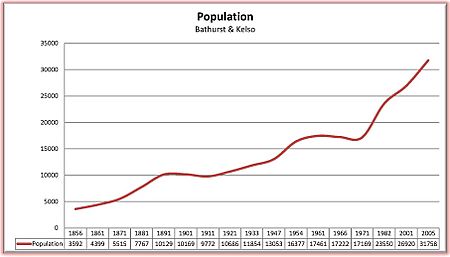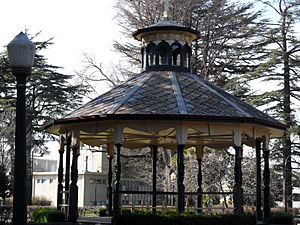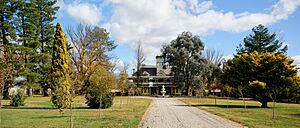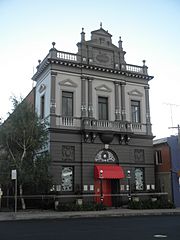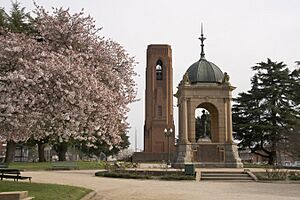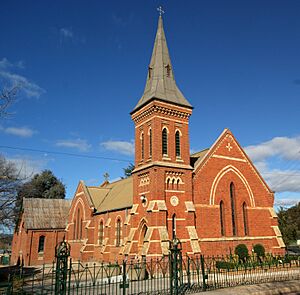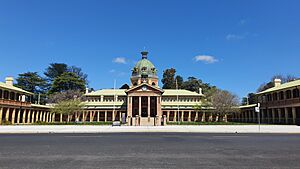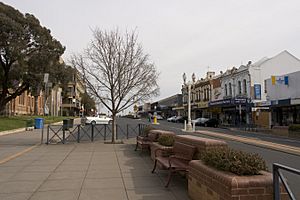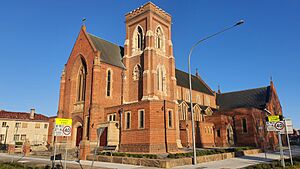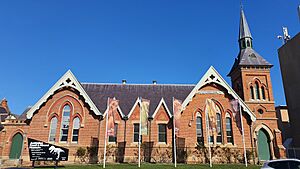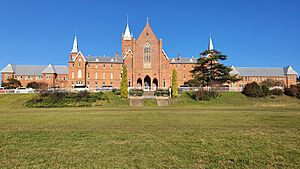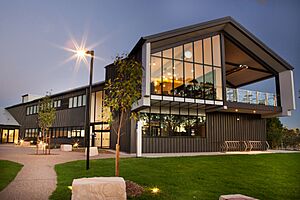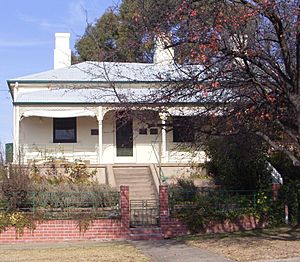Bathurst, New South Wales facts for kids
Quick facts for kids BathurstNew South Wales |
|||||||||
|---|---|---|---|---|---|---|---|---|---|
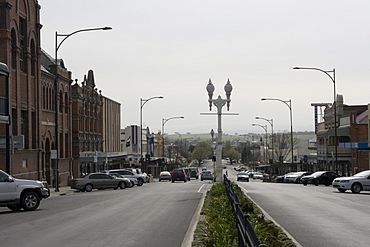
William Street
|
|||||||||
| Established | 1814 | ||||||||
| Postcode(s) | 2795 | ||||||||
| Elevation | 650 m (2,133 ft) | ||||||||
| Location | |||||||||
| LGA(s) | Bathurst Regional Council | ||||||||
| Region | Central West | ||||||||
| State electorate(s) | Bathurst | ||||||||
| Federal Division(s) | Calare | ||||||||
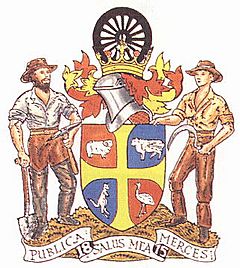 |
|||||||||
|
|||||||||
Bathurst is a city in the Central Tablelands of New South Wales, Australia. It's about 200 kilometres (120 miles) west of Sydney. Bathurst is the main town for the Bathurst Regional Council area.
The city was started in 1815, making it the oldest inland settlement in Australia. In 2021, about 37,396 people lived there.
Bathurst is often called the "Gold Country". This is because Australia's first big gold discovery happened here in 1851. This led to the country's first gold rush! Today, the city's economy relies on education, tourism, and making things. The famous Mount Panorama racetrack is a well-known landmark. Bathurst also has a historic city centre with many beautiful old buildings from the gold rush days.
Contents
History
The land around Bathurst was originally home to the Wiradjuri Aboriginal people.
Early Days and the Gold Rush (1800s-1860s)
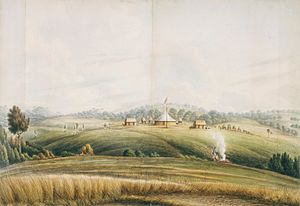
In 1813, a government surveyor named George Evans was the first European to see the Bathurst Plains. This happened after the first successful European journey across the Blue Mountains that same year.
In 1814, Governor Lachlan Macquarie asked William Cox to build a road over the Blue Mountains. This road would connect Emu Plains (near Sydney) to the Bathurst Plains. The road was 12 feet wide and about 101 miles long. It was built quickly, in just six months, by 30 convict workers and some soldiers.
Governor Macquarie himself drove his carriage across the new road in April 1815. On 7 May 1815, he officially named the future town of Bathurst. He named it after Henry Bathurst, 3rd Earl Bathurst, who was an important government official. Bathurst became Australia's oldest inland town. It was meant to be the main centre for the western plains of New South Wales.
Local Wiradjuri groups, led by people like Windradyne, resisted the new settlers. These conflicts, part of the Australian frontier wars, ended in the early 1820s. The first settlement of Bathurst was on the eastern side of the river in 1816, in what is now the suburb of Kelso.
In its early years, Bathurst was a starting point for many explorers. These included George Evans in 1815, John Oxley in 1817–1818, Allan Cunningham in 1823, and Thomas Mitchell in the 1830s.
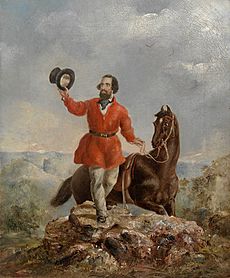
Small amounts of gold were found in the Fish River in 1823. But it was on 12 February 1851, in a Bathurst hotel, that Edward Hargraves announced he had found enough gold to make it worth mining. Soon, more gold was found at Ophir and Hill End in the 1850s.
Hill End became famous for the "Holtermann Specimen" found on 20 October 1871. This was the largest single piece of gold ever discovered in the world! It was a huge chunk of quartz rock mixed with gold, weighing 630 pounds. When the gold was separated, it produced about 205 pounds of pure gold.
In the 1860s, Bathurst grew very quickly. It became Australia's first gold centre. Gold from nearby areas was brought to Bathurst before being sent to Sydney. This made the coaches carrying mail and gold a target for bushrangers (outlaws).
In 1830, a large group of over 80 convicts, known as the Ribbon Gang, caused trouble in the Bathurst area. They were caught and faced serious consequences. Ten members of the Ribbon Gang were executed in Bathurst on 2 November 1830. The place where this happened is now marked by "Ribbon Gang Lane" in the city centre.
Ben Hall, a well-known bushranger, was married in Bathurst in 1856. In October 1863, his gang robbed shops and tried to steal a racehorse in Bathurst. They returned a few days later to rob more businesses.
The discovery of gold in 1851 completely changed Bathurst's economy. The number of hotels and inns grew a lot. The first licensed inn opened in 1835. By 1875, during the gold rush, there were 61 hotels operating at the same time!
City Growth (1860s-1910)
The Cobb & Co. company, which ran horse-drawn coaches, moved its main operations to Bathurst in 1862. They followed the gold rush, providing services to transport gold, mail, and passengers. Cobb & Co. coaches were built in Bathurst workshops. You can see a restored Cobb & Co. coach at the Bathurst Information Centre.
Bathurst also became important for coal mining and manufacturing. The Main Western railway line from Sydney reached Bathurst in 1876. This made Bathurst a key railway hub with workshops and offices. Today, it's still a regional centre for railway engineering.
By 1885, Bathurst had about 8,000 people, with another 20,000 in the surrounding area. It was a major hub for stores, supplying goods across western NSW and even into Queensland and South Australia.
Modern Development (1910s-1940s)
During this time, Bathurst slowly but steadily grew. New industries like manufacturing and education developed. Important services like town gas, electricity, and town water systems were put in place.
Town gas arrived in Bathurst in 1872. Electric street lights were switched on in 1924, replacing gas lights. A modern sewage treatment system was built in 1915. Water supply improved with the Winburndale Dam in 1933 and later the Ben Chifley Dam in 1956. The Ben Chifley Dam was upgraded in 2001 to hold 30% more water.
An ambulance service started in 1925. The NRMA began offering roadside assistance in 1927. The local radio station 2BS started broadcasting on 1 January 1937. Bathurst Aerodrome opened in 1942, helping with the war effort. Commercial flights to Sydney began in 1946.
A famous Australian frozen food brand, Edgell, started in Bathurst. Robert Gordon Edgell arrived in 1902 and began growing fruits and vegetables. By 1926, he opened a small cannery. His company, Gordon Edgell & Sons, became a well-known Australian food brand.
Many attempts were made to start a university college in Bathurst. Real progress happened in 1947 with plans for a teachers college. The first students arrived in 1951. This college later grew into the Charles Sturt University in 1989.
Bathurst was considered as a possible site for Australia's new capital city in 1901. People thought it was a good choice because of its central location, healthy environment, and strong defence possibilities.
During World War II, an Army camp was set up in Bathurst in 1940. After the war, this camp became a centre for new migrants coming to Australia. The first migrants arrived in 1948, and sometimes the centre housed up to 10,000 people.
Population Growth
Bathurst has had periods of fast population growth. This happened during the gold rush in the 1800s and after World War II when many migrants settled here. More recently, at the start of this century, the population has grown quickly, partly due to people moving from Sydney.
Geography
Bathurst is located on the western edge of the Great Dividing Range. It sits on the Macquarie River plain, also known as the Bathurst plains. The city is next to the Macquarie River, which is part of Australia's largest river system, the Murray-Darling basin. A levee bank protects the city from floods.
Mount Panorama is only 3 kilometres from the city centre. It is 877 metres (2,877 feet) above sea level and rises 215 metres (705 feet) above the city.
Bathurst is located next to the Great Western Highway, which starts in Sydney. Two other main highways, the Mitchell Highway and the Mid-Western Highway, also start in Bathurst. The city is also on the Main Western Railway line, which connects it to Sydney.
The Macquarie River divides Bathurst, with the main city area on the western side. Four road bridges and two rail bridges cross the river in the city. These include the Evans Bridge (opened 1995) and the historic Denison Bridge (opened 1870), which is now a pedestrian bridge.
Land and Climate
The Bathurst region has two main parts: the Bathurst Basin and the Tablelands. Rivers like the Macquarie, Turon, Fish, and Campbells Rivers flow through the area. The central basin has granite soils. The northern area has sandstone and other rocks, with some small volcanoes. The south has a mix of different rock types.
The land ranges from gently rolling hills to very steep country. About 30 km east of Bathurst is the Great Dividing Range, a large mountain range.
Bathurst has a cool temperate climate. This means it has mild to warm summers and cool to cold winters. Thunderstorms are common in summer. Bathurst gets about 107 clear days each year.
In winter, light snow sometimes falls on the higher peaks around Bathurst. On 12 January 2013, Bathurst recorded its highest temperature ever, 40.2 °C (104.3 °F).
| Climate data for Bathurst (1909-2012) | |||||||||||||
|---|---|---|---|---|---|---|---|---|---|---|---|---|---|
| Month | Jan | Feb | Mar | Apr | May | Jun | Jul | Aug | Sep | Oct | Nov | Dec | Year |
| Record high °C (°F) | 40.2 (104.4) |
40.1 (104.2) |
35.3 (95.5) |
32.0 (89.6) |
24.2 (75.6) |
20.5 (68.9) |
20.5 (68.9) |
23.5 (74.3) |
29.0 (84.2) |
34.1 (93.4) |
39.7 (103.5) |
37.5 (99.5) |
40.2 (104.4) |
| Mean daily maximum °C (°F) | 28.0 (82.4) |
27.2 (81.0) |
24.5 (76.1) |
20.1 (68.2) |
15.7 (60.3) |
12.2 (54.0) |
11.3 (52.3) |
12.9 (55.2) |
16.4 (61.5) |
19.9 (67.8) |
23.3 (73.9) |
26.3 (79.3) |
19.8 (67.6) |
| Mean daily minimum °C (°F) | 13.3 (55.9) |
13.3 (55.9) |
10.8 (51.4) |
6.7 (44.1) |
3.4 (38.1) |
1.6 (34.9) |
0.6 (33.1) |
1.3 (34.3) |
3.4 (38.1) |
6.2 (43.2) |
8.9 (48.0) |
11.6 (52.9) |
6.8 (44.2) |
| Record low °C (°F) | 1.8 (35.2) |
2.8 (37.0) |
−2.2 (28.0) |
−5.0 (23.0) |
−6.2 (20.8) |
−8.2 (17.2) |
−8.9 (16.0) |
−7.5 (18.5) |
−4.8 (23.4) |
−2.7 (27.1) |
−1.0 (30.2) |
0.0 (32.0) |
−8.9 (16.0) |
| Average rainfall mm (inches) | 68.6 (2.70) |
58.9 (2.32) |
51.9 (2.04) |
41.3 (1.63) |
41.8 (1.65) |
44.0 (1.73) |
48.6 (1.91) |
49.2 (1.94) |
47.0 (1.85) |
59.5 (2.34) |
61.1 (2.41) |
66.1 (2.60) |
638 (25.12) |
| Average rainy days (≥ 0.2mm) | 7.4 | 7.1 | 6.2 | 6.2 | 8.2 | 10.1 | 11.1 | 10.9 | 9.3 | 9.3 | 8.5 | 8.0 | 102.3 |
| Average relative humidity (%) | 42 | 46 | 46 | 49 | 57 | 63 | 61 | 54 | 52 | 48 | 46 | 39 | 50 |
| Source: Bureau of Meteorology | |||||||||||||
City Centre and Neighbourhoods
Bathurst's main city centre is around William, George, Howick, Russell, and Durham Streets. It has banks, government services, shops, and a park.
Bathurst has kept a mix of main street shops and indoor shopping centres. Kings Parade, a park in the city centre, has several memorials. It's a popular place for people to meet. Keppel Street is another shopping area, a couple of blocks south of the main centre.
The main neighbourhoods (suburbs) of Bathurst include Kelso, Eglinton, West Bathurst, Llanarth, South Bathurst, Gormans Hill, Windradyne, Windradyne Heights, and Abercrombie Estate. Marsden Estate in Kelso is one of the newer neighbourhoods.
Historic Places

Bathurst has many places listed for their historical importance. These include:
- All Saints Anglican Cathedral Church Street: All Saints Cathedral Bells
- Bathurst City Library 70–78 Keppel Street: Bathurst Old School of Arts Library Collection
- Bathurst Street Lamps, found throughout the city centre
- Bentinck Street: Bentinck Street Elm Trees
- 67 and 71 Bentinck Street: Bentinck Street houses
- Browning Street: Bathurst Correctional Complex
- 10 Busby Street: Ben Chifley's House
- 218 Gormans Hill Road: Merembra Homestead
- Havannah Street: Bathurst railway station
- Howick Street: Old Bathurst Hospital
- 194, 196, 198, 200 and 202 Howick Street: Howick Street houses
- Kendall Avenue (Great Western Highway): Bathurst Showground
- Macquarie River, Great Western Highway: Denison Bridge
- Main Western railway: Macquarie River Railway Bridge
- 3249 O'Connell Road: The Grange and Macquarie Plains Cemetery
- Russell Street: Bathurst Courthouse
- 321 Russell Street: Miss Traill's House
- 16 Stanley Street: Old Government Cottages Group
- 107 William Street: Cathedral of St Michael and St John
- 108 William Street: Royal Hotel
Landmarks
Bathurst has many important monuments, buildings, and parks that show its place in Australia's history.
In the city centre is a square called Kings Parade. It used to be a market area. Now it's a public park with gardens and three memorials.
The Bathurst War Memorial Carillon is a 30.5-metre (100-foot) tall tower in Kings Parade. It remembers soldiers who died in the two World Wars. The bell tower has 49 bronze bells that ring daily. It also has an eternal flame. The Carillon was finished on 11 November 1933.
The Evans memorial is at the northern end of Kings Parade. It was completed in 1920. This memorial remembers George Evans, who discovered the Bathurst Plains in 1813.
The Boer War memorial is at the southern end of Kings Parade. It was unveiled in 1910 by Lord Kitchener.
People of Bathurst
| Historical population | ||
|---|---|---|
| Year | Pop. | ±% |
| 1921 | 9,440 | — |
| 1933 | 10,413 | +10.3% |
| 1947 | 11,871 | +14.0% |
| 1954 | 16,089 | +35.5% |
| 1961 | 16,938 | +5.3% |
| 1966 | 17,230 | +1.7% |
| 1971 | 17,196 | −0.2% |
| 1976 | 18,589 | +8.1% |
| 1981 | 19,640 | +5.7% |
| 1986 | 22,237 | +13.2% |
| 1991 | 24,682 | +11.0% |
| 1996 | 26,029 | +5.5% |
| 2001 | 26,920 | +3.4% |
| 2006 | 28,992 | +7.7% |
| 2011 | 31,294 | +7.9% |
| 2016 | 33,587 | +7.3% |
| 2021 | 37,396 | +11.3% |
| Source: Australian Bureau of Statistics data. | ||
In 2021, Bathurst had 37,396 people.
- About 7.7% of the people were Aboriginal and Torres Strait Islander.
- Most people (84.6%) were born in Australia.
- The most common languages spoken at home were English (87.4%).
- The most common religions were No Religion (32.6%), Catholic (28.7%), and Anglican (15.2%).
How Bathurst is Governed
Local Government
Bathurst was first declared a town in 1852. It became a city on 20 March 1885, the same day Sydney became a city. The Bathurst Regional Council was formed in 2004. It combined the Bathurst City Council with other nearby areas.
State Government
The Electoral district of Bathurst is the area that elects a representative to the NSW Parliament. This area includes Bathurst and Lithgow, plus parts of other local government areas.
Federal Government
Bathurst is part of the federal electoral district of Calare. This district covers a large part of western NSW.
Economy
Bathurst has a diverse economy. It includes manufacturing, a large education sector, and government services.
To help Bathurst grow, the Regional Council plans to build a new Australian Centre for Science, Technology and Emerging Industries (ACSTEI). This "Technology Park" will be next to the Charles Sturt University campus. It aims to attract new, modern industries.
Manufacturing and Food
Some large private companies that employ many people in Bathurst include Devro, which makes food casing products, and Mars Petcare, a pet food manufacturing plant. Other companies like Telstra (a phone company), Simplot Australia (known for brands like Edgells and BirdsEye), and Burkes Transport (a trucking company) also have large operations here.
Public Sector
Many government organisations also employ a lot of people in Bathurst. These include Country Energy, Charles Sturt University, Bathurst Regional Council, the NSW Land Registry Services, the Western NSW Local Health District, Bathurst Correctional Centre, and the New South Wales Police Force.
Farming and Forests
Bathurst's cool winter climate is good for growing stone fruits and grapes for wine.
The Bathurst Primary Industries Centre is a government facility that has been operating since 1895. It studies different types of farming. It is still one of Australia's most important research centres for stone fruit.
Sheep and wool production are the main farming industries in the area. Beef cattle are also raised. Large plantations of softwood timber (like pine trees) are harvested for wood products. Bathurst is the main office for the Macquarie Region of Forestry Corporation of NSW.
Motorsport

Bathurst is famous for motorsport. It is home to the Mount Panorama motor racing track. This track hosts big races like the Bathurst 12 Hour in February and the Bathurst 1000 in October. During these races, the city fills with tourists.
When there are no races, the circuit is a public road. It's a popular place for visitors to drive around. Bathurst has a long history of racing, starting with motorcycles in 1911. The first race at Mount Panorama in 1938 attracted 20,000 spectators. In 2006, the Bathurst 1000 had a crowd of 194,000 people.
Next to the circuit is the National Motor Racing Museum. This museum has motorcycles and cars that show Bathurst's racing history. A sculpture dedicated to famous race car driver Peter Brock is located in the museum grounds.
Sports
Sports are very popular in Bathurst. The Bathurst Regional Council and the NSW State Government have invested a lot of money in new sports facilities. These include a heated Aquatic Centre, an Indoor Sports Stadium, and a Hockey Complex.
The city has special facilities for motor racing, Rugby League, Rugby Union, Australian Rules football, Athletics, Cricket, Netball, Tennis, Football (soccer), and Touch Football. There are over 70 different sports groups in the region. Cycling is a growing sport in Bathurst, with great roads and facilities. The Bathurst Cycling Club is one of Australia's oldest sports clubs, started in 1884.
Some sports grounds in Bathurst are:
- Alan Morse Park – for cricket and athletics
- Anne Ashwood Park – for rugby union
- Bathurst Sportsground – for cricket, rugby league, rugby union, and athletics
- Bathurst Indoor Sports Stadium – for basketball, volleyball, netball, soccer, and badminton
- Brooke Moore Oval – for cricket
- Carrington Park – for rugby league and rugby union
- Cooke Hockey Complex – with grass and synthetic hockey fields
- Cubis Park Facilities – for cricket, rugby league, and soccer
- John Matthews Complex – for netball and tennis
- Kennerson Park – for greyhound racing
- Proctor Park – for soccer
Gliding is also popular in Bathurst. Gliding takes place at Pipers Airfield and the Bathurst Regional Airport. Young people from the Australian Air Force Cadets learn to fly gliders here.
Bathurst also hosts modern sports events like Newtons Nation at Mount Panorama. Young people can take part in sports like BMX Dirt Bikes, Mountain Bikes, Wakeboarding, and Skateboarding.
Culture
Bathurst is a city with cathedrals, meaning it's the main seat for the Anglican and Roman Catholic bishops. The city has many churches and religious buildings. The main cathedrals are All Saints' (Anglican) and St Michael and St John's (Catholic).
Bathurst was also the home of Ben Chifley, who was an Australian Prime Minister during wartime. He is buried in Bathurst.
Bathurst has several house museums that show different periods of its history. These include Old Government Cottage (built 1837–1860), Abercrombie House (a large mansion from the 1870s), Miss Traill's House (built in 1845), and Chifley Home. Chifley Home shows how Prime Minister Chifley lived a simple life.
Bathurst has several museums. The Bathurst Historical Society Museum has Aboriginal artefacts and documents about Bathurst's early history. The Australian Fossil and Mineral Museum has a large collection of fossils and minerals. It even has Australia's only complete Tyrannosaurus rex skeleton! This museum is in a historic school building in the city centre.
Arts groups in Bathurst include the Mitchell Conservatorium, which teaches music to children and adults. The Bathurst Regional Art Gallery focuses on Australian art and local landscapes. It holds about 25 exhibitions each year. The Macquarie Philharmonia is an orchestra that brings together professional and amateur musicians from western NSW.
The Carillon Theatrical Society has been performing musicals since 1959. Arts OutWest is a group that promotes arts and culture in the Central West area of NSW.
The Bathurst Memorial Entertainment Centre (BMEC) is a modern building opened in 1999. It hosts local and international performances.
The historic Royal Bathurst Show is an Agricultural Show that has been running since 1860. It promotes farming and industry and provides entertainment. It's one of the largest regional shows in NSW, attracting about 25,000 people over three days.
The Central Tablelands region is known for its gourmet food and drink. A group called Bre&d organises the monthly Bathurst Farmers Markets. They also hold annual events like Bre&d Under the Stars and Bre&d on the Bridge, which show off local chefs and produce on the historic Denison Bridge.
Things to See and Do
- Yerranderie Regional Park
- Evans Crown Nature Reserve
- Abercrombie House
- National Motor Racing Museum
- Trunkey Creek
- Abercrombie Caves
- Bathurst Regional Art Gallery
- Gold Panner
- Bathurst Panthers
- Annie's Old Fashioned Ice Cream
Education
Education is Bathurst's biggest industry. It has 60 education facilities, employing 12.1% of the local population.
Bathurst is the main location for Charles Sturt University. It's a major university that provides education for the region. The university is well-known for its journalism courses.
The Western Institute of TAFE has two campuses in Bathurst. It offers training in many areas like arts, building, business, computing, and tourism.
Western Sydney University also has a medical education facility at Bathurst Hospital for its medical students.
Bathurst has many primary and high schools, both public and private. These include the Scots All Saint's College, Denison College, MacKillop College, and St. Stanislaus College.
Transport
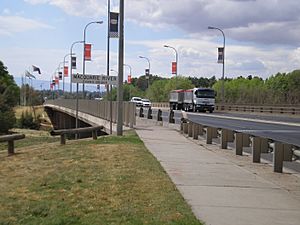
Roads
Bathurst is a regional highway hub. Several important roads start here, including the Great Western Highway, Mid-Western Highway, and Mitchell Highway.
Rail
Bathurst railway station is a short walk from the city centre. NSW TrainLink trains and buses connect Bathurst to Sydney, Dubbo, Parkes, and Cootamundra.
Buses
Local bus services are provided by Bathurst Buslines, operating in the city's neighbourhoods. There are also bus services connecting Bathurst to nearby towns like Lithgow, Orange, and Oberon. Long-distance coaches also travel between Bathurst and Sydney.
Bathurst's Growth Plans
Bathurst's location near Sydney and on major highways has made it a good place for government plans to encourage growth outside of big cities.
One plan in the 1970s was the Bathurst Orange Development Corporation (BODC). This aimed to make Bathurst and Orange a "growth centre" by bringing in new businesses and people. Several large employers, like Devro and Mars, moved to Bathurst as part of this plan.
More recently, in 2010, a new plan called EVO Cities was launched. This plan encourages people to move to regional cities like Bathurst by advertising the "Energy, Vision and Opportunity" they offer.
Famous People from Bathurst
- Charles Bean (1879–1968), a war correspondent and historian, born in Bathurst.
- George Bonnor, (1855–1912), an Australian cricketer.
- Brian Booth (1933–2023), a test cricketer and Olympic hockey player.
- Ben Chifley (1885–1951), an Australian Prime Minister.
- Brendan Cowell (1976–), an actor and director.
- William Cox (1764–1837), who built the first road from Sydney to Bathurst.
- Andrew Denton (1960–), a television presenter.
- Robert Gordon Edgell (1866–1948), who founded the Edgells food company.
- George William Evans (1780–1852), the first European to see the Bathurst area.
- Peter O'Malley (1965–), an Australian professional golfer.
- Tommy Raudonikis (1950–2021), an Australian rugby league player.
- Mark Renshaw (1982–), an Australian professional cyclist, born in Bathurst.
- Rodney Keft (A.K.A. Rodney Rude) (1943–), an Australian comedian.
- Tim Storrier (1949–), an Australian painter.
- Archie Thompson (1978–), a famous A-League footballer.
- Windradyne (around 1788–1835), a Wiradjuri Warrior.
Media
Newspapers
The local daily newspaper is Western Advocate. It has been published in Bathurst for 150 years.
Radio Stations
Bathurst has several local radio stations:
- 2BS FM 95.1 (commercial)
- B-Rock FM 99.3 (commercial)
- 2MCE-FM 92.3 (community radio)
- Life FM 100.1 (Christian community radio)
National radio stations available include:
- ABC Central West 549 AM
- NewsRadio 98.3
- Radio National 104.3/96.7
- Triple J 101.9/95.9
- Classic FM 102.7/97.5
- SBS Radio 88.9 MHz (multicultural radio)
- Vision Radio 1629 AM
- Racing Radio 2KY 100.9
Television Stations
Television in Bathurst is broadcast from a tower on Mount Panorama. Channels available include:
- 7 Regional, 7two, 7mate, 7Bravo, 7flix, ishopTV and Racing.com (from the Seven Network).
- WIN Television: Nine, 9Gem, 9Go, 9Life, TVSN and GOLD (Nine Network channels).
- Southern Cross 10, 10 Bold, 10 Peach, 10 Shake, SBN and Sky News Regional (Network 10 channels).
- ABC TV, ABC TV Plus, ABC Me and ABC News (from the Australian Broadcasting Corporation).
- SBS TV, SBS Viceland, SBS World Movies, SBS Food, NITV and SBS WorldWatch (from the Special Broadcasting Service).
- Subscription Television services are provided by Foxtel.
Local news bulletins for the Central West are produced by Seven News and WIN Television.
Sister Cities
 Ōkuma, Japan (since 1991)
Ōkuma, Japan (since 1991) Iiyama, Japan
Iiyama, Japan
Images for kids
See also
 In Spanish: Bathurst (Australia) para niños
In Spanish: Bathurst (Australia) para niños




